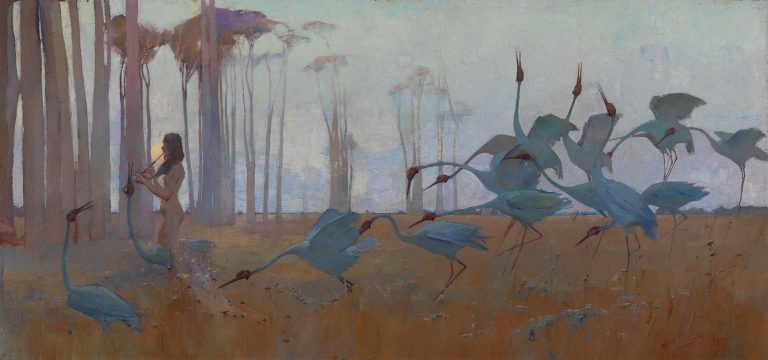We acknowledge the Traditional Owners of the land on which the Queensland Art Gallery | Gallery of Modern Art stands and recognise the creative contribution First Australians make to the art and culture of this country.

Sydney Long / Australia 1871–1955 / Spirit of the Plains 1897 / Oil on canvas on wood / 62 x 131.4cm / Gift of William Howard-Smith in memory of his grandfather, Ormond Charles Smith, 1940 / Collection: Queensland Art Gallery | Gallery of Modern Art / © Ophthalmic Research Institute of Australia (ORIA)
Sydney LongSpirit of the Plains 1897
On Display: QAG, Gallery 11
In Spirit of the Plains 1897, Sydney Long introduced a mythological theme into Australian painting. The work evokes a distant, dreamlike and identifiably Australian landscape, featuring the brolga, a wetland bird found in northern Australia and well known for its elaborate mating dance.
Long’s depiction of the brolga’s delicate movements is one of the most rhythmical and haunting images in nineteenth-century Australian art. The artist used the flat, decorative shapes of the Art Nouveau style to link the flock of birds and the trees into one flat plane. He created a vision of Australia where birds and people appear united by music.
This joyous portrayal is in striking contrast to early scientific studies of birds, common in Australian painting at that time. Long wanted the Australian landscape to ‘free the imagination of the figure painter, employing soulful and graceful evocations of the spirit of the land, as did the Greeks and their beautiful myths’.1
Endnotes:
1. Lois Hunter, The Australian Art Companion, Reed Books, Sydney, 1990, pp.90–1.
Born at Goulburn, New South Wales, Sydney Long moved to Sydney in 1888. While working as a clerk, he attended classes at the Royal Art Society of New South Wales and in 1894, when he was 23, his work was purchased by the Art Gallery of New South Wales. He became a protégé of artist Julian Ashton and was able to make a living by teaching and undertaking commissions. In 1907 he worked with Ashton at the new Sydney Art School.
Thanks to the popularity of his lyrical bush paintings, by 1910 Long had enough money to realise his greatest ambition, to study in London. Returning to Australia in 1925, he co-founded the Australian Painters, Etchers and Engravers Society, and for many years served as director. He died in 1955, three years after returning to England.
Discussion Questions
1. How does the title of the work, Spirit of the Plains, relate to the image presented in the painting?
2. Count the number of birds you see in this painting. How would you describe the movement of the birds?
3. What do you think the music in the painting sounds like?
4. Reflecting on the Australian landscape painting tradition, what make this an unusual image?
Classroom Activities
1. List the art elements and techniques the artist has used to give this painting a mythical presence. Write a myth based on this painting. Share it with your class.
2. Create a landscape of a familiar location that is suggestive of music. Select a suitable piece of music and write a brief synopsis which links the image with your chosen music.
3. Create a story about the work that captures a moment in time, just before or after this image.
4. Listen to a song and create an artwork in response that reflects the mood and movement of the music.